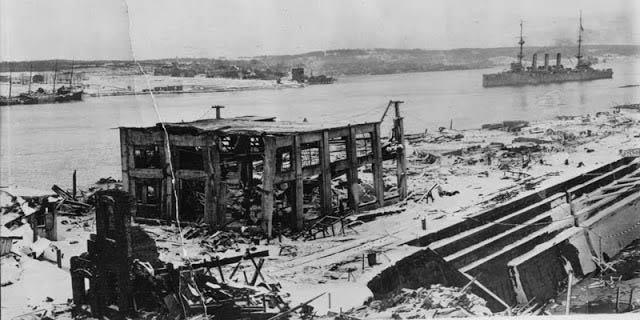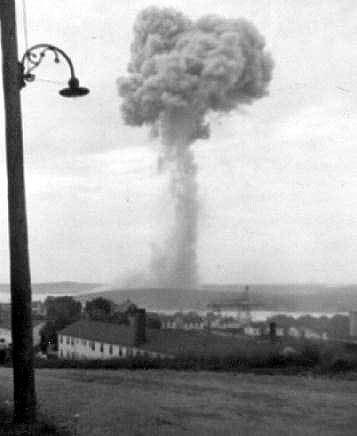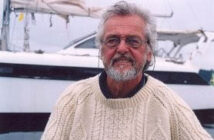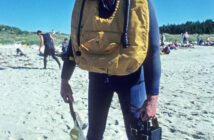As Canada celebrates its 150th birthday this year it is worth noting that a war has never been fought on its land. But the weapons of warfare brought death and destruction to Halifax, Nova Scotia, on Canada’s Atlantic seaboard 100 years ago. On December 6, 1917, the French ship Mont-Blanc left its anchorage at Halifax to join a convoy that would cross the Atlantic en route to the First World War battle grounds.

The Harbour after the explosion in a detail from a panoramic photograph by Maclaughlin with SS Imo to left and HMS Highflyer to right. MMA, MP207.1.184/1b
The Maritime Museum of the Atlantic (part of the Nova Scotia Museum) reports that the ship was loaded with 10 tons of gun cotton and 35 tons of benzol, “a highly explosive mixture.” Simultaneously, a Norwegian ship, Imo, was leaving for New York to pick up relief supplies for Belgium. The Imo hit Mont-Blanc’s bow, triggering a fire. Expecting an explosion the crew abandoned ship in lifeboats and headed for the Dartmouth shore.
The burning ship attracted attention onshore. Not realizing the danger they faced, some unfortunately became spectators instead of fleeing immediately. That was a costly mistake. The Mont-Blanc exploded at 9:06 a.m. The Maritime Museum of the Atlantic said 1,630 homes were destroyed, another 12,000 houses were damaged and 6,000 people lost their shelter. “Hardly a pane of glass in Halifax and Dartmouth was left intact.” The death toll exceeded 1,900, 9,000 were injured and 37 persons lost their sight. One-fifth of Halifax lay in ruins. It was the world’s largest man-made explosion until it was surpassed by the two atomic bombs dropped on Japan during the Second World War.
 The disaster was worsened by a blizzard that struck Halifax that night, leaving the homeless out in the cold. Sixteen inches of snow was dumped on Halifax. The power of the explosion caused a huge tidal wave that triggered even more death and destruction.
The disaster was worsened by a blizzard that struck Halifax that night, leaving the homeless out in the cold. Sixteen inches of snow was dumped on Halifax. The power of the explosion caused a huge tidal wave that triggered even more death and destruction.
The response to the disaster was heartwarming. That night Boston sent a train loaded with supplies, medical personnel and members of its public safety committee to Halifax. Help poured in from all over Canada and many parts of the world. The continuing generosity of the state of Massachusetts led to an ongoing response from Nova Scotia. Each year it gives a huge Christmas tree to Boston as a symbol of its appreciation for that city’s kindness in Halifax’s time of need.
As bad as the disaster was, it could have been much worse if it had not been for a courageous Canadian telegraph operator named Vincent Coleman. He selflessly decided not to run from probable death. Instead, he sent a telegraph that could be picked up by any train in the area, advising the crews not to enter the Halifax rail yards, which are adjacent to the harbour. One of those trains about to arrive in the disaster area was carrying 700 passengers. Hearing his message, it stopped safely short of their destination.
The Canadian Railway Hall of Fame inducted Coleman into its “heroes” category, a fitting tribute for man who sacrificed his own life for others. He must have known he was doomed. His last telegraph message read: “Guess this will be my last message. Good-bye boys.”









1 Comment
Pingback: "The Flying Sailor", an animated short about the Halifax Explosion, snags Oscar Nomination - Go Scuba Diving Bahamas